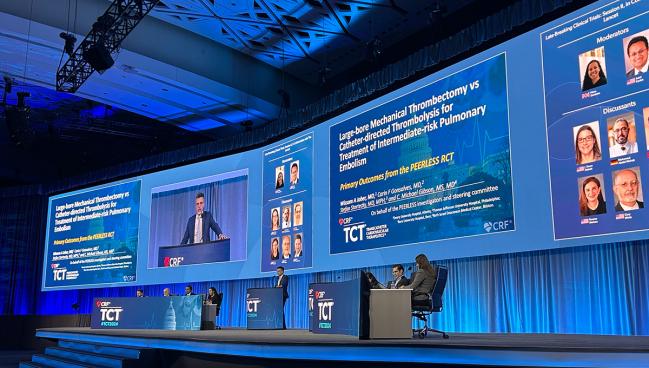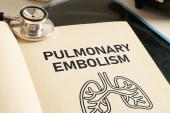PEERLESS: FlowTriever Tops Catheter-Directed Thrombolysis for Acute PE
(UPDATED) The trial adds much-needed randomized data to an area where it’s been lacking. Questions about methods muddy interpretation.

WASHINGTON, DC—In PEERLESS, the first randomized controlled trial pitting two different interventional strategies against each other in pulmonary embolism (PE), patients with acute intermediate-risk PE fared better over the short term if they received large-bore mechanical thrombectomy with the FlowTriever system (Inari Medical) rather than catheter-directed thrombolysis.
As Wissam Jaber, MD (Emory University Hospital, Atlanta, GA), showed here at TCT 2024, a hierarchical primary endpoint measured early after the procedure favored thrombectomy, with a win ratio of 5.01 (95% CI 3.68-6.97). That was driven by less clinical deterioration and/or bailout as well as less use of intensive care. There were no differences in mortality, intracranial hemorrhage, or major bleeding.
The FlowTriever procedure also improved several measures of early recovery at 24 hours and was associated with shorter total hospital stays and a lower 30-day readmission rate.
At a press conference, Jaber noted that the standard-of-care in PE is anticoagulation and catheter-based interventions are being compared against medical therapy in other ongoing trials; the PEERLESS results, published simultaneously online in Circulation, will have to interpreted in the context of those when they’re available.
“The issue of comparing both therapies to each other is a question for the interventional community,” he added, “because both have been used in increasing frequency throughout at least the United States and probably also outside the United States. The question has always persisted as [to] which one is better for the patient’s short-term [outlook].”
Commenting for TCTMD, Sahil Parikh, MD (NewYork-Presbyterian/Columbia University Irving Medical Center, New York, NY), pointed out that this is the largest randomized trial ever done in PE, with most other studies being registries or small RCTs. “It’s starting to really bring the best of evidence-based medicine to bear on this field. . . . It’s really, really important to have this caliber of data,” he stressed.
The difference in clinical deterioration and/or bailout observed in PEERLESS was unexpected, Parikh said. It is common to see “patients who decompensate and wind up either crashing onto ECMO or needing surgical embolectomy or needing another thrombectomy procedure,” he continued. “So if the data suggests that treating them more aggressively up front is actually going to prevent future decompensation, that is definitely going to be a factor now in how we decide to triage up-front treatment for these patients.”
Though there have been other data released in recent years that have raised some questions about safety, this trial shows that these techniques are safe, Parikh noted. “These data seem consistent with what your intuition would be, that if you treat them earlier, you won’t have to treat them later. And we’ve seen this in PE before with early thrombolysis data.”
The size of the trial increases confidence that the findings “are probably real and probably meaningful,” he said. “Is it a home run that is going to change the field forever? Not yet, but they have PEERLESS II on the heels of this, which is going to be another huge trial.”
First Randomized Head-to-Head Comparison
About 10 years ago, results of the PEITHO trial showed that fibrinolytic therapy consisting of tenecteplase plus heparin reduced hemodynamic decompensation but increased risks of major bleeding and stroke in patients with intermediate-risk PE. Since then, the field has seen development of catheter-based interventions like catheter-directed thrombolysis and large-bore mechanical thrombectomy, though evidence to support their use has remained thin.
PEERLESS, conducted at 57 sites in the United States, Germany, and Switzerland, is the first RCT to compare different catheter-based interventions with discrete mechanisms of action for intermediate-risk PE.
Investigators randomized 550 patients (mean age roughly 62 years; 47% women) to one of the two interventions. All had intermediate-risk PE with acute symptom onset within the last 14 days, a clot in the main or lobar pulmonary arteries, systolic blood pressure > 90 mm Hg, RV dysfunction, and at least one additional risk factor, such as an elevated cardiac biomarker level or heart rate. The plan was to perform the interventions within 72 hours.
The FlowTriever system was used for thrombectomy, whereas the catheter-directed thrombolysis devices varied. The EKOS endovascular system (Boston Scientific) was used in more than half of case (59.8%); the second most common, used in 23.2%, was the Cragg-McNamara micro therapeutics infusion catheter (Medtronic). The median total dose of tissue plasminogen activator administered per patient was 16.0 mg.
Procedures were longer with the FlowTriever (mean 95.8 vs 70.8 min) and were associated with higher estimated blood loss (mean 87.7 vs 14.4 mL).
The primary endpoint was a hierarchical assessment of all-cause death, intracranial hemorrhage, ISTH major bleeding, clinical deterioration and/or escalation to bailout, and postprocedural ICU admission and length of stay, assessed using a win ratio at hospital discharge or 7 days after the procedure, whichever was shorter. The win ratio favored the FlowTriever procedure versus catheter-directed thrombolysis, driven by significantly lower rates of clinical deterioration and/or bailout (1.8% vs 5.4%; P = 0.04) and less ICU use (P < 0.001), including lower rates of admission (41.6% vs 98.6%) and stays over 24 hours (19.3% vs 64.5%).
A secondary endpoint that left ICU use off the hierarchical endpoint did not show a difference between the trial arms (win ratio 1.34; 95% CI 0.78-2.35).
Is it a home run that is going to change the field forever? Not yet, but they have PEERLESS II on the heels of this, which is going to be another huge trial. Sahil Parikh
At the 24-hour visit, several clinical variables showed faster recovery in the FlowTriever arm, with reductions in respiratory rate (mean 18.3 vs 20.1 breaths/min; P < 0.001) and lower rates of moderate to severe mMRC dyspnea score (13.5% vs 26.4%; P < 0.001), NYHA class III/IV symptoms (16.3% vs 27.4%; P = 0.002), and moderate or severe RV dysfunction (42.1% vs 57.9%; P = 0.004). RV/LV ratio reduction was similar in the two arms (mean 0.32 vs 0.30; P = 0.55).
FlowTriever-treated patients had shorter total hospital stays (mean 4.5 vs 5.3 overnights; P = 0.002), as well as fewer all-cause readmissions in the first 30 days (3.2% vs 7.9%; P = 0.03). At that time point, there was no difference in mortality (0.4% vs 0.8%; P = 0.62).
Safety was similar with either intervention as well, with no difference between the FlowTriever procedure and catheter-directed thrombolysis in serious adverse events related to the device or drug through 30 days (13.3% vs 11.5%; P = 0.59).
Methodological Questions
Speaking with TCTMD, Akhilesh Sista, MD (Weill Cornell Medicine, New York, NY)—principal investigator of PE-TRACT, an ongoing RCT evaluating a variety of catheter-based interventions for PE versus standard-of-care anticoagulation—raised some issues about the study design that call into question some of the PEERLESS trial’s conclusions.
A win ratio analysis comes with many of the limitations of a composite endpoint in that not all of the components are equal in terms of clinical meaningfulness, he said. In this case, the first three are objective endpoints—mortality, intracranial hemorrhage, and major bleeding—that showed no difference between interventions.
The last two—clinical deterioration/bailout and ICU stay—are more subjective, he said. Escalation of therapy for bailout is based on physician judgement, which may vary widely between centers, and thus it’s not valid to combine it with clinical deterioration, Sista said. Examined alone, there were only 14 cases of deterioration in the trial (10 in the catheter-directed thrombolysis arm and four in the FlowTriever arm), he observed, so it’s questionable whether there’s enough statistical power to conclude that there’s a true difference.
What that means is that the win for thrombectomy comes from a difference in length of stay, which also can be influenced by multiple factors, Sista said. For instance, at some hospitals, patients who no longer need intensive care may remain in the ICU because there aren’t enough beds for them elsewhere. Jaber acknowledged, too, that an ICU stay is part of standard protocols for catheter-directed thrombolysis at most hospitals.
“You've really come down to a study which says that in the current modern practice of PE and the practice patterns of where patients are housed, the real difference between these is length of stay, and that is not a very compelling argument to routinely use [large-bore thrombectomy] over [catheter-directed thrombolysis] in my perspective,” he said.
These considerations need to be taken into account when it comes to the messaging from the trial, Sista argued. “This is not necessarily a win for [large-bore thrombectomy], he said. “In the way, it was designed a priori with the win ratio, and with the statistical mechanics of it, yes, you could say that this was a win for [FlowTriever] based on the way they designed it. But the clinical practice of PE intervention shouldn't be influenced by a statistical consideration.”
Overall, with more trials on the way, the PE community should know that all will come with their own strengths and limitations, Sista said, noting that all have different sponsors as well. “That needs to be a part of the examination of these trials, their outcomes, and their conclusions. The conclusions that come from the paper need to be looked at critically, and we need to make sure that the messaging is appropriate for the design and the results that are embedded within the trials and not just the conclusions of the sponsor.”
More Trials Coming
Parikh said PEERLESS is “really a major opening salvo in the randomized trials for PE,” noting that multiple RCTs will be reporting results in the coming years that provide insights into comparative effectiveness, safety, and long-term efficacy. Those include HI-PEITHO, PE-TRACT, and STORM-PE. “In aggregate, they’re going to change the field,” he predicted.
Then, in the future, strategy trials “will even further increase our ability to discriminate what’s the right patient for the right procedure and at the right time,” he said.
In the meantime, PEERLESS helps the field have an open dialog about trial methodology, and which endpoints are most important to patients, physicians, and payers, as well as which are going to predict long-term outcomes, Parikh said. “We don’t have any studies telling us about that, and that’s sort of the Holy Grail of this space.”
Also critical will be trials evaluating whether any of these interventions are needed over standard-of-care anticoagulation, which is being studied in ongoing trials like PEERLESS II, HI-PEITHO, PE-TRACT, and STORM-PE.
PEERLESS helps set the stage for those trials, showing that it’s possible to do an RCT this big “in this space in an area where equipoise is difficult to find,” Parikh said. “There are believers who believe that treatment is the right thing to do. And they can continue to treat patients the way they think is right because it’s safe.”
If the trials comparing catheter-based interventions versus anticoagulation all point toward a benefit of intervening, it will change guidelines, he predicted.
Parikh underscored the importance of finding answers in acute PE, which remains the third leading cause of cardiovascular death behind MI and stroke. “We talk about other things at this meeting—structural heart disease, chronic total occlusions, other complex intervention techniques. But from a public health standpoint, this is going to have a really big impact.”
Todd Neale is the Associate News Editor for TCTMD and a Senior Medical Journalist. He got his start in journalism at …
Read Full BioSources
Jaber WA, Gonsalves CF, Stortecky S, et al. Large-bore mechanical thrombectomy versus catheter-directed thrombolysis in the management of intermediate-risk pulmonary embolism: primary results of the PEERLESS randomized controlled trial. Circulation. 2024;Epub ahead of print.
Disclosures
- The PEERLESS trial is sponsored by Inari Medical.
- Jaber reports research grants/funding from Inari Medical, Medtronic, and Thrombolex; consulting fees from Abbott, Inari Medical, and Medtronic; and being an advisory board member for Thrombolex.
- Parikh reports receiving grant Support/research contracts from Shockwave Medical, TriReme Medical, Surmodics, Abbott, Boston Scientific, and Concept Medical; serving on advisory boards for Abbott Vascular, Boston Scientific, Medtronic, BD, and Cordis; receiving consulting fees/honoraria/speaking fees from Abiomed, Terumo, Inari Medical, Penumbra, and Shockwave Medical; and having equity/stock(s)/options from Encompass Vascular and Advanced Nanotherapies.
- Sista reports no relevant conflicts of interest.






Comments